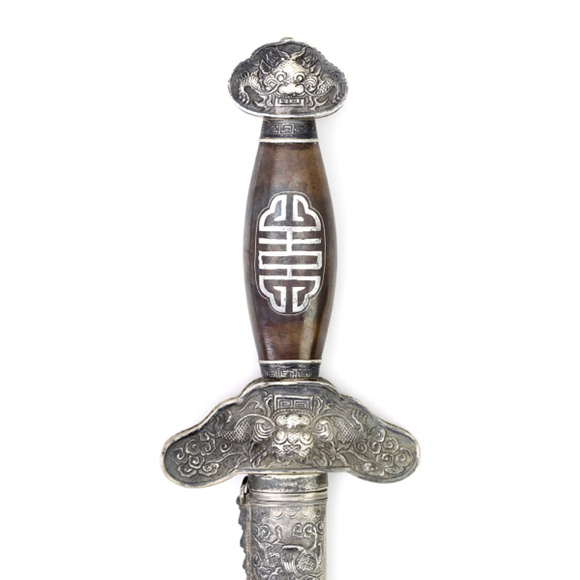A very rare ceremonial variety with copper scabbard inlaid with different alloys, and a brass blade.

76.5 cm
58.2 cm
Base 8.5 mm
Middle 5 mm
5 cm from tip 3 mm
Base 33.5 mm
Middle 33.5 mm
5 cm from tip 27 mm
740 grams
14 cm from hilt
Iron, steel, wood, horn
Tonkin, Northern Vietnam
Before 1887
Victor Auguste Robin (1847-1907)
Senior officer of the Tonkin expeditionary force 1885-1887.
Description
A Vietnamese fighting saber incorporating a blade after the Chinese style, with a moderate curve over its entire length. It features two grooves on the right and three grooves on the left. Additional floral engraving is added on both sides, executed with a small chisel and depicting stylized floral work in typical Vietnamese fashion. It is forge folded, the layering just visible in its current finish.
It has a forged iron circular guard with a Japanese-inspired washer, called seppa in Japanese. These small Japanese design influences remind of the 16th and 17th centuries when many Japanese settled in the area. Their culture eventually got assimilated into local culture, but small hints of their presence such as this one remain.
The hilt is simply fashioned out of a piece of wood with a horn cap as a pommel and braided rattan as a ferrule. The center portion of the grip is ribbed for a comfortable and secure hold. It thickens near the pommel, a typical feature of the area. I get the impression this is a later, makeshift handle put on an older blade.
Condition
Original condition, no recent repairs. Some edge damage from use. See photos.
Provenance
It comes from the collection of Victor Auguste Robin (1847-1907), senior officer of the Tonkin expeditionary force from April 12, 1885, to August 23, 1887. He was awarded with the Ordre national de la Légion d'honneur, the highest French order of merit and also the Order of the Dragon of Annam and the Royal Order of Cambodia.










An exceedingly rare set with fine mother of pearl inlaid string board
Collected by a Russian prince from the hill peoples of central Vietnam in 1892.
An understated, elegant khukuri of substantial proportions with fine layered blade.






